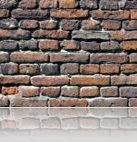Severe chinks opened when I accidentally came across a town history book for Bristol, New Hampshire while killing a little time. Thumbing through its pages, I found a reference to my 3rd great grandparents that stated that grandma had died in Walworth, Wisconsin. Interestingly, they never lived in or near Bristol.
My 5th great grandfather lived there during the end of his life and was included in the town history. His biography included a list of his descendants and included in the list was his granddaughter, my great grandmother, Mary Adith Tirrill and her husband, Thomas Farrar.
After looking for them in Walworth with no success for another decade, a newly published booklet was published by the Walworth County Genealogical Society that included cemetery transcriptions. I happened to be in the Family History Library in Salt Lake City on the day it was first put on the shelf and probably had the first success mining its data.
The next day, I contacted the Society and one of the wonderful members agreed to go to the rural Brick Church Cemetery and take photos of the Farrar graves. By the end of the week, I had them in my possession and they confirmed that Thomas Farrar had lost his wife, his mother and his son within a few months of each other. All were buried together and their names and dates were on their headstones.
The brick wall lost its integrity when I read the inscription of Thomas’ mother. “Elizabeth, wife of Eli Farrar died July 18, 1857 aged 62 years”.
Knowing his parents names opened a new window for continued research. Unfortunately, they were recent immigrants from England and I could only guess where they had lived before coming to America. While in the FHL, I found the citizenship papers of Thomas Farrar and his brother, John. They stated that the men were from England, so that fact was proven.
Searching the BDM records on Rootsweb, I found a listing for a John Farrar’s marriage to Selina Thornton in Huddersfield, Yorkshire. The couple left England before the next British census so no record of them was found as a family.
Looking through the U.S. Census records I found them listed in the 1850 census in Lexington County, South Carolina along with three children. Also living in the same home was John’s brother, Thomas (my great grandfather) and his wife “Edith” who was born in New Hampshire.
Mary Adith Tirrill was born and raised in the far north end of New Hampshire in the small town of Stewartstown. How the couple met is still a mystery to me but it was easy to imagine the census taker mistakenly hearing “Edith” in the Yorkie accent of the Farrar’s in the home.
At that point the trail went cold.
Flash forward six years. I had posted the data and headstone photos on my website hoping someone who had additional information would find them. That ‘someone’ did. As far as I can determine, only he was the only living person who could help me with the data needed to push the tree farther back in time.
His deceased aunts had known John and Selina Farrar in life and had asked them about their lineage. John gave them the names of his parents, Eli Farrar and Elizabeth Shaw and the name of his grandfather, David Farrar. He also gave them the names of his siblings and of his Farrar aunts and uncles and the fact that they all lived in and around Huddersfield.
The family had moved frequently in a westward migratory path, hence my problem finding church records for them. Without their names, I probably wouldn’t have found the family. I had spent many weeks looking through church records on microfilm in the search in Huddersfield and in ever expanding concentric circles outward without success. My time and resources were almost expended by the time I was contacted.
Subsequently , I found the passenger records for Eli and Elizabeth Farrar and the record of their youngest son, William who joined them in America. All three had followed their other two sons to a new homeland. Within a couple of years, all three of them had died.
What steps worked in knocking down this wall?
- Gathering all records, letters and notes already in my possession and reviewing them for hint with a fine toothed comb.
- Pure luck in finding and browsing through the town history book of Bristol, New Hampshire.
- Hundreds of hours searching through census records (this was before they were digitized and online).
- Looking for any spelling of the Farrar surname in records. Thomas, John, Selina and their children were listed as “Fanan” in the ship passenger records. Additionally, Selina was listed as “Sibla”.
- Matching the names of family members with the census information found in the 1860, 1870 and 1880 census to overcome future spelling problems. The Yorkie accent seems to have continued to cause enumerators to mis-hear the family surname and some of the childrens names.
- Posting requests for help along with what I knew on every forum I could think of.
- Posting the family data on my website in the hope someone would find it and contact me. (They did. We win).
- Constantly reviewing everything I’d found over the years as well as setting aside a day every month to look at all the subscription and free sites for new records that had been posted.
- Not giving up. Even after 30+ years of actively searching.

